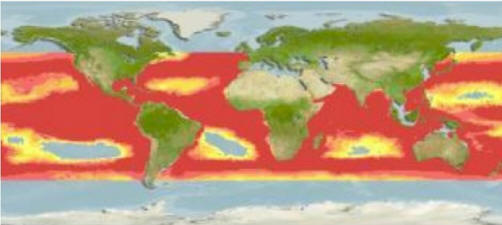Habitat
Melocetus johnsonii can be found throughout much of the oceanic environments spanning the globe, therefore, water depth should be taken into account. This species of anglerfish can be found within the mesopelagic realm (from 200 to 1000m) as well as parts of the bathypelagic region (1000m to 6000m) where light from the surface is not a factor. Temperatures are very low, around 2 degrees C with intense water pressure. Many fish have to cope with the perpetual darkness of the mesopelagic region and have evolutionary adaptations in order to navigate through the region and find prey.
Suitable and most likely habitats for M. johnsonii are shown in red according to specimens collected. Yellow regions include possible locations, and grey/blue regions include areas where the humpback anglerfish is not found
source:
Computer Generated Native Distribution Map for Melanocetus
johnsonii (Humpback
anglerfish). www.aquamaps.org, version of Aug. 2013.
The mesopelagic realm and bathypelagic regions where this organism lives lacks photosynthetic plants and primary productivity. Some species present include detritovores, resident carnivores, or smaller scavengers. For detritovores and other scavengers, food sources include molted exoskeletons, fecal pellets, dead organisms and plant matter from the mesopelagic zone above. Resident carnivores include animals like Melanocetus johnsonii that remain in waiting for other organism. Many have luring mechanisms to bring prey closer in order to save energy. Common features of fish within this region include bioluminescent structures, large body forms, and an absence of a swim bladder.
Source: Edith Widder / EOL. License: CC BY
Attribution-Noncommercial-
Continue learning about some of the
evolutionary adaptations
of this amazing fish or return
home.

